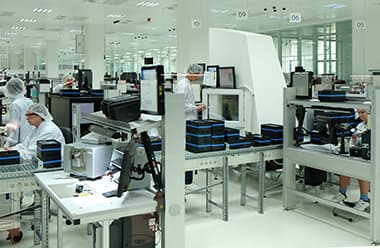A rare photo of workers at the Wetzlar factory, in an area where photography is allowed [credits: C Cheesman]

Leica CEO Alfred Schopf addresses journalists ahead of an interview with AP in Wetzlar, Germany
Leica opens new factory and marks 100 years
Leica makes first new film camera in 10 years
AP
How much will production increase at the new Wetzlar plant?
AS
It’s roughly 50% in terms of [extra] space… Solms had its limitations in terms of climatisation [sic]. For optics you always need a certain humidity. When it got hot in the summer you couldn’t manufacture any more, so all this kind of stuff was rather difficult to handle in Solms… we are expecting we can improve significantly in that regard, especially in strange weather conditions.
AP
Can you put a figure on it?
AS
Everything I say would be speculation. But we can expect at least a 50% higher production capacity… maybe even 70% or 80% because you can restructure the manufacturing differently… but we don’t have a specific target, we just do it step by step.

A sign inside the factory prohibits photography inside the optical workshop, to protect the secrecy of work processes
AP
Will it be faster to turn around a camera from start to finish than it was?
AS
In optics you cannot be fast [on a factory tour AP was told that it can take around a week to make one lens]… without suffering in terms of quality.
We are taking speed out of the whole thing and looking more into accuracy. For example, the 50mm f/2 lens is a product developed on the edge of physical capability. We are offering 40 lines of resolution (sic) on every corner of the lens. If I were to just do 35 lines, I could double the manufacturing speed, but that’s not the promise we give our customer and, price wise, what they expect is a certain quality level. This is where we stick to values and we say we deliver what we promise.
Of course, on the one hand there are a lot of people around us saying Leica is rather expensive. On the other, they know when they are buying something that the quality, or price/performance relation, is fair.

AP
Are you able to better monitor quality here than in the old furniture factory in Solms?
AS
Well, not only monitoring the quality but we can even improve the steps of the [manufacturing] process. For a lot of things you need a ‘clean room’… cleaner air, for example, and in the old building that was rather messy. You changed the filters four times a year but the whole environment was so old that in the end you always had to go for a compromise.
AP
So, are delays in the availability of new products less likely now?
AS
We hope so, but we cannot guarantee it. Doing a prototype is always easy, doing 10 prototypes is also easy, but doing a line of products, with a set quantity, you get hiccups.
We now have a level of sophistication, especially on the optics side. Since joining the company (in 2010) we did 20 Noctilux lenses a month over the next three years. We have improved that to 240. It was hard work, but whenever we improved our capability, requests from market increased as well.
AP
What was the thinking process behind the decision to make lenses for the Leica T in Japan?
AS
In that particular class [of camera] we wouldn’t be able to maintain manufacturing in Germany, because it’s a different price point than our M product. It’s a fully Leica design, under Leica’s quality control, and we are happy that we found a manufacturing partner in Japan who is doing the whole thing for us..
[Schopf would not divulge the name of the partner, but confirmed, as AP has reported previously, that it is not Panasonic]
AP
Was it a logistical problem to make T lenses in Wetzlar?
AS
We already run the M line and S line of lenses. We wanted to avoid T lenses all of a sudden influencing the capability of manufacturing these.
I don’t say we would never do a ‘made in Germany’ lens for the T system. It may be that in one or two years’ time, when we have improved our manufacturing capabilities, that we will do these as well.
AP Some people are wondering if Leica will launch a full-frame T camera.
AS
Let’s wait and see… Whatever I say can be misinterpreted. Might Leica show up with a full-format camera at some point, with an autofocus? Yes. Don’t ask me about the design.
AP
Is there any research and development into this going on right now?
AS
I can’t comment on that.
AP
Leica seems a robust business now, compared to, say, five or six years ago. How confident are you that Leica is strong now financially?
Let me put it this way. Last year, the market went down 40% in [sales] terms. Leica grew over 5% and, if you account for the Japanese yen exchange rate differences, it would be another 4% in turnover.
[Schopf said revenue ‘doubled’ in the three years after 2009]
Will we grow again at this rate in the next couple of years? Well, I think that the market is against us for the time being, but we are quite confident that with the portfolio we are offering, and how we have positioned it, that it has the ability to grow.
If the market this year goes down another 20-30%, will it influence Leica? In some way, yes.
[Schopf suggested that, as Leica’s share of the overall photo market is low, he expects the company would, in any case, be the ‘last to suffer’.]









